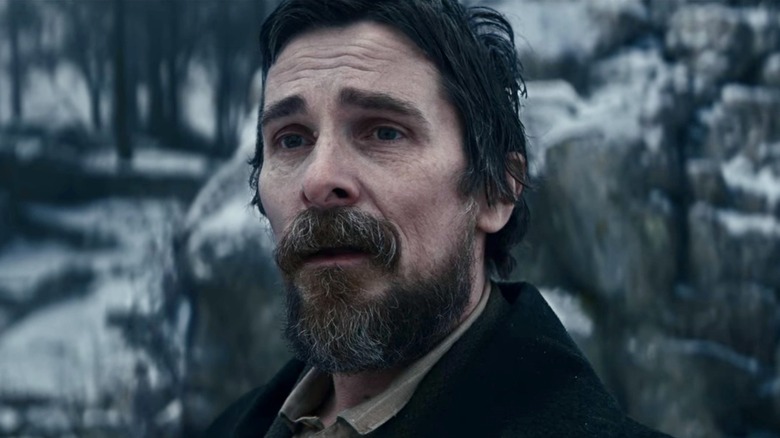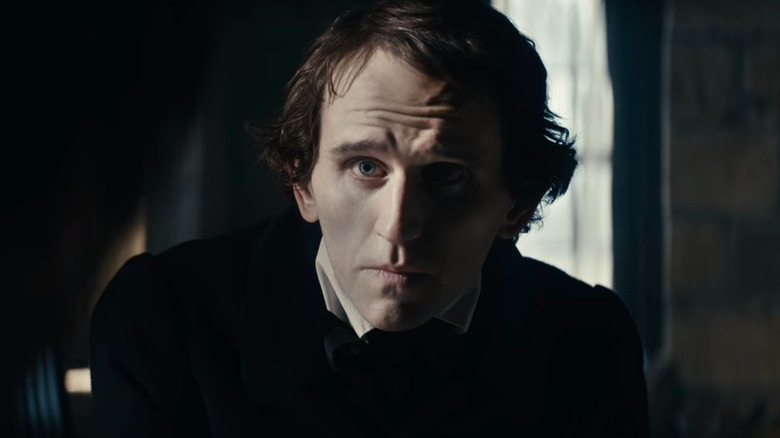The Pale Blue Eye's Final Scene Took 12 To 14 Hours To Film
This post contains spoilers for the ending of "The Pale Blue Eye."
With a 130-minute runtime, Netflix's "The Pale Blue Eye," based on the novel by Louis Bayard, reaches a fiery climax with about half an hour left to go. Just when you think it's over and detective Augustus Landor (Christian Bale) has solved the central murder mystery, the movie keeps going, delivering a final twist ending on top of that.
Viewers are with Landor the whole film as he investigates the grisly death and organ removal of more than one cadet at the West Point military academy with the help of his new friend, Edgar Allan Poe (Harry Melling). Suspicion falls on the Marquis family, and in a histrionic scene, we see three members of that family, including Poe's love interest, Lea Marquis (Lucy Boynton), about to remove his telltale heart in a Satanic ritual.
Landor comes to the rescue and Lea and her brother go up in flames, but the movie's true ending comes with the resolution of the plot line involving Landor and his missing daughter. It arrives when Poe shows up at Landor's cabin and confronts him in a comparatively quieter dialogue scene where there are no black magic incantations and it's just two men talking.
In an interview with ComingSoon, director Scott Cooper discussed this "final" (technically, penultimate) scene in "The Pale Blue Eye," and how it was all shot in one long day. Cooper said, "It was not an easy scene to film and leading up to that point, as the director, you want to leave breadcrumbs for people to see upon a second viewing — should they watch the film a second time — that they could have really picked up early on, some of the clues that lead to that particular scene."
'The entire film rests on the success of that scene'
Cooper also discussed the importance of leaving a strong last impression with the penultimate scene of "The Pale Blue Eye," saying:
"I think we shot that scene in an entire day, maybe a 12 or 14-hour day, where everything comes to the fore — the entire film rests on the success of that scene. The ending, arguably, is always the most important thing in any movie. It's the last thing the viewer will think about. Everything has been building to that particular moment. If the endings don't work, well then the film is not going to work. Whether the film has wonderful performances, production design, you've created a great tone, aesthetic, world ... everything has to come together emotionally, has to come together psychologically ... it has to come together in ways that feel honest."
"The Pale Blue Eye" is certainly one of the more interesting films Scott Cooper has made since his Oscar-winning directorial debut, "Crazy Heart." I'd need to see it a second time, as he suggests, to pick up on some of those "breadcrumbs" he mentioned. But there's one moment at the end where Timothy Spall's character expounds on what he (incorrectly) assumes regarding the murders, and Landor sort of tips his hand and says, "You can assume that, yes."
Whether or not it hangs together logically, "The Pale Blue Eye" at least has a more memorable ending than Cooper's two previous collaborations with Bale, "Out of the Furnace" and "Hostiles." Much of the credit for that goes to Bale and Melling, who, in their final scene together, really sell the emotional believability of their friendship unraveling as we learn that Landor killed the cadets in retaliation for them assaulting his daughter and driving her to her death.

